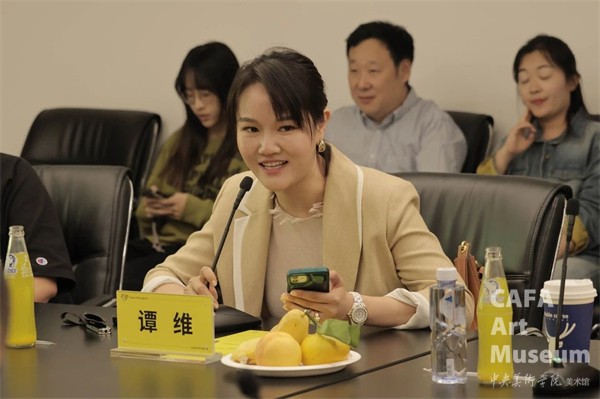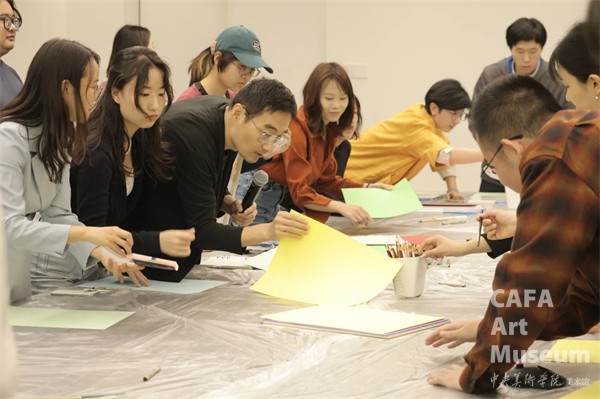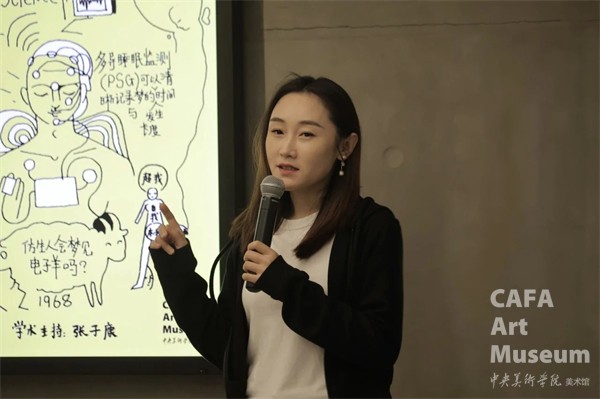
“广角°—青年实验项目空间”第一期第五回展览“化梦:李洋的艺术”于2023年10月18日在中央美术学院美术馆二层C 展厅圆满落下帷幕。作为强调实验性的展览项目,“化梦”展的策划以“社会性”为基点探索了如何建立展览与社会公众之间有效的智识链接以及美术馆社会美育的多元模式。展览期间,举办了以“梦”为核心的系列学术活动,包括“梦作为艺术创作的方法”研讨会、“梦与创造力——画梦工作坊”(成人场、儿童场)以及策展团队专题导览。

“梦作为艺术创作的方法”
学术研讨会
研讨会时间:2023年10月7日 下午2:00
研讨会地点:中央美术学院会议室
主办:中央美术学院美术馆
学术主持:张子康
学术召集:纪玉洁、李洋
研讨会嘉宾(按发言顺序):周博、谭维、张晨、赵炎、段少锋、王垚力



研讨会学术主持张子康致辞概述

张子康(中央美术学院美术馆馆长、教授)
祝贺“化梦”展览在中央美术学院美术馆成功举办。十年前,我曾在798艺术区见过艺术家李洋的作品,但是今天看了他的展览后,我对他的认知发生了重大改变。他以梦作为艺术创作的核心展开实践,延续了相当长的时间,产出了如此出色的作品,我认为“梦”这一主题很值得深入研究。
本次策展的精彩之处在于,把梦境作为艺术创作的方法进行探讨,在策展领域应该是首次尝试,有一定的突破性。展览分为两条线索,一条是艺术家的梦境创作与梦境日记,另一条是与社会关联的线索,即艺术家的梦境与当下社会思考的连接。两条线索构成了艺术家在创作中与社会、生活、自我思考的不间断联系与建构,使梦境成为他的创作灵感和语言方法,这一点十分有趣。展览另一个引人注目的方面是,李洋研究了来自世界各地,多个文化情境的不同梦的典故、梦的事件,将其与个人独特的梦境认知相融合。这种独特的研究方式与认知是随着他的创作和对梦的思考的逐渐深入而逐渐形成。同时,他还受到了科学和心理学的影响,如在医院进行的梦境监测实验等。这种科学性的研究行为本身也可视为一种新的艺术创作方式,为展览增色。
我还注意到,参加此次研讨会的专家,既有资深学者,还有年轻学者,这也体现出梦境这一主题对于当代年轻学者一代的吸引力和关联性。这种关联可能会启发未来的艺术创作发展思路,具有重要的学术价值。最后,我代表中央美术学院美术馆感谢大家的光临,特别欢迎大家参加这次充满学术内涵的研讨会。谢谢!
研讨会学术召集人纪玉洁发言概述

纪玉洁(中央美术学院美术馆设计总监、副研究员)
本次学术研讨会的议题“梦作为艺术创作的方法”是从李洋的艺术创作经历,结合“化梦”展挖掘提炼出来的。梦有很强的主观性和虚构性,通常作为创作的灵感来源或是创作题材,选择梦作为艺术创作的主题,常常是为了表达神秘、奇异、虚幻。然而并不是所有的艺术家对梦有很好的直觉和敏感度,可以像达利那样,把梦境的主观世界转变为客观形象,为超现实主义艺术的发展做出贡献。与意大利电影大师费里尼一样,李洋也掌握了一项特异功能,他能够记住梦,并在醒来后可以很快把梦描绘出来,把梦视觉化。李洋很聪明,他把这一优势与艺术创作上结合起来,非常坚定的把梦作为对象,持续30多年从没有间断和改变,梦成为了他创作的根与魂。李洋不仅描绘梦境中的形象、情境、氛围、叙事,同时他也深入研究梦的本体问题,梦产生的原因,梦的实质,梦与人的潜意识、心理的关系,还从个体的私密的梦延展至集体梦的潜意识、社会、历史、时代等议题,他还与研究梦的科学家合作,探究生理数据与视觉图像的相互印证关系。而这些研究反过来,作用于他那些扑朔迷离的梦境图像描绘,使得他的作品叙事更有深度和广度,呈现更加宏阔的结构,丰富了内涵,加深了意义。从这个意义上看,梦不仅仅是一种表现内容与语言,成为他的艺术创作的一种方法,也就有了我们这次的议题。希望来自不同研究背景的专家学者从各自的视角回应并延展这个话题,以更加开放、自由的方式进行,也欢迎批判与反思的声音。
研讨会嘉宾发言概述
(按发言顺序)

周博(中央美术学院设计学院教授)
关键词:从无意识出发、“梦”与“想”的融合
李洋本科比我高一届,研究生是一届的同学,住在一个宿舍。我研究生的方向是西方近现代美术,易英老师让我写温克尔曼,我每天阅读的著作、想的问题主要都跟科学革命、启蒙思想、德国古典哲学有关,基本上都是理性主义和经验主义的东西,启蒙运动相信理性能够引导人类走向康庄大道。然而,李洋同学却一直对神秘主义保持着一种非凡的学术兴趣,我们经常讨论。
从李洋的成长路径上来看,其实在他来到中央美院壁画系之前就开始关注梦境,我们从他早期的作品中可以看到这一点。到了壁画系之后,壁画系的训练对他有很大的影响。壁画创作有设计的层面,因为它要在一张巨大的画面上交错时空的安排各种各样的图像,其实与超现实主义的手法比较接近。所以,学壁画的同学似乎也比较容易接受超现实主义。研究生毕业之后,李洋留校工作,我继续读博士。有一段时间,艺术市场比较好,我也建议他考虑一下市场的接受度,他虽然表面上也应承一下,但其实不为所动,一直在坚持他自己的一套东西。一晃30年过去了,这种坚持是我最佩服他的一点。
回到咱们的讨论问题,就是梦作为艺术创作的方法。我之前也问过他,为什么是“梦”?为什么不是“梦想”?因为超现实主义的创作,里边不可能全是无意识,一定是有意识、有理性的东西在里边的。所以,我一直觉得李洋的作品里有“想”这个层面,不能全是“梦”。其实在超现实主义里边,“自动书写”可能是更贴近于无意识。但是,一旦变成有形的形象的组合,变成洛特雷阿蒙说的“缝纫机与雨伞在手术台上的偶然相遇”,那你不可能没有构图、没有安排,没有理性,也就是“想”这个层面的参与。所以,我一直觉得李洋作品里边有他的“梦”也有他的“想”的成分。
当然,在就李洋的创作思路里边隐含着现代艺术从无意识出发的一个创作路径。也就是在他的品里面,我觉得一直是有这样一条线索的。超现实主义,包括基里柯、形而上画派也好,他们的艺术所追求的是把一个神秘的、奇特瞬间凝固到一张画面上。这个神秘的时刻可能夹杂着暴力、血腥和色情的内容,看起来并不舒服。在超现实主义这个阶段,主要还是弗洛伊德的理论在发会影响。到抽象表现主义的时候,已经不是弗洛伊德套东西在影响艺术了,而是荣格的集体无意识这套理论影响更大。梦,作为艺术的一个特别直接的创作方法,到抽象表现主义这里基本上就终结了。后来,从偶发艺术之后,无意识主要是通过行为和表演实现的,但在无意识之外有理性的、步骤性的操控。艺术家在艺术的行为中设定一个程序,无意识是在这个艺术的程序里面去参与创作,最后出来这么一个作品。
所以,我觉得就李洋的艺术而言,虽然说我们讨论的主题是梦作为艺术创作的方法,但其实在他的作品里边,早期有超现实主义和弗洛伊德理论的影响,再往后,他开始做小红军、纪念碑之类的东西,又都融入了集体无意识,反映了70 年代末期、 80 年代初期物质生活比较匮乏的那样一个阶段,很多东西都会进入到李洋的梦境,进入到他的画面。再到后来,李洋的创作更多的会跟行为艺术的线索有关系。那么,在行为的过程中,其实无意识、有意识都在参与他的创作。所以,这 30 年下来,他自己的创作思路其实就反映了一个对于现代艺术史某一个脉络的学习、理解和再创造。所谓以梦作为艺术创作的方法,其实是把上面这几个层次的东西都融汇到一起了。
当然,西方现代艺术的这条线索不能够完全涵盖李洋的创作方法。他的一些作品中其实还有佛学和老庄的底子,我们要知道,东方的哲学和人文也是谈梦的,比如庄周梦蝶、红楼梦等等,这方面李洋也读了不少书,做过一些探索。也就是说,在李洋的方法论中,除了西方的资源,还有中国的传统文化语境。当然,这次的展览没有触及这样一些作品,不过我还是觉得应该把中国文化对于梦境的思考这个问题提出来供大家思考。

谭维(北京大学当代中国史料馆、中国当代艺术档案馆馆长)
关键词:媒介、个人微观史、感性与理性
当观展方式从PDF到原作,李洋老师的展览打破了时间和空间的限制进行全面的交流以及改变艺术领域中的诸多面向;展览感性和理性的交融使展览具有强烈的反差感,这种反差感及震撼作为吸引观众的新势力时需要我们进行深入探讨:
第一,艺术家对于媒介的突破。对于架上艺术家、装置艺术家或影像艺术家来说,他们有自己频繁使用以及擅长的媒介,使艺术创作具有极强的相似性。李洋老师作为一个突破型艺术家,从未匡借自己在绘画媒介上的使用范围,在创作中使用油画、纸本 、丙烯以及新媒体材料以外将感性的艺术创作和理性严谨的科学实验进行融合,跨越传统单一的创作范式。
第二,艺术家的创作方法。李洋老师将创作方法作为对微观宇宙史的描绘,这种宇宙非常私人化,私人化的宇宙与现实宇宙产生某些关联性,就像平行时空,当现实还未发生时,他的梦境似乎超前于现实发生并具有一定的预见性。
第三,艺术家个人微观史的记录。李洋老师从1997年开始通过对手稿和梦境完成个人微观史的记录,对于档案研究来说,旁证、本证和佐证是研究的核心。基于李洋老师的展览发现,李洋老师的本证是碎片化的梦境,旁证是基于梦境所记录的文字和画,佐证是使用记录仪检测梦的时间段;这种微观史的记录反映整个时代的变迁及社会的切片展示,通过这种记录能观察到他们70年代一批人的成长路径以及创作媒介的变化,使整个展览的内涵不局限于对梦的描绘,进而转向对个人跟社会的链接和对历史的记录。
如果当所有东西变成理论过后,就会变得非常理性和枯燥,对一个艺术家来说更多的是感性以及非理性的东西更吸引人。当梦作为艺术创作的方法而不是方法论时,使展览在感性与理性的交织缠绕中指向更为复杂的链接。

张晨(中央美术学院人文学院副教授)
关键词:无意识的转化、集体创作、欲望生产
我想分享一个我自己有关展览的梦境,在开幕之前的一天,我梦见自己参观了展览,并惊讶地发现它与真实的开幕式有相似之处。如果从弗洛伊德的理论来解释这个梦,则可能是因为我没能实际参加开幕而内心感到愧疚和遗憾,这样的情感在梦中找到了无意识的弥补方式。
在弗洛伊德那里,梦境被看作是内心世界的动态斗争,它有可能脱离理性的控制,它在一定程度上超越了现实,反映出无意识层面的欲望和情感;但与此同时,它又在自我、本我和超我之间有着复杂的互动,比如在我的梦里,会有从对于美术馆空间的了解、个人知识体系的角度对于展览本身的想象,但同时它又是虚构的,又与真实有着一定的距离,发生了某种矛盾和变化,所以梦既是无意识的流露,同时又需要被解释。
在弗洛伊德的理论下,梦被视为力比多(libido)的驱动,是无意识的转化。这一精神分析的观点启发了艺术史中的超现实主义者,他们试图通过无意识的概念来寻找艺术作品中更为真实的主题。早期的超现实主义采用了一种以取消个人身份为代价的方式,如自动书写和集体创作,他们将个体的作者扩展为整体,以探索更深层的创作自由。这种创作方式不属于特定的某个人,而是一种集体的努力,它超越了个体的差异,体现了超现实主义的独特维度。
通过放弃个体和作者的特殊性,超现实主义试图接近无意识层面的真实,这是超现实主义所采用的多种方法之一。同时,它也与荣格所说的集体无意识和原型心理学等相关。个体的思想和观点在此不是重点,重要的是处在社会整体层面的集体无意识的流露。
总之,弗洛伊德、超现实主义、布列东和荣格都在试图追寻真实的自我,但如果按照拉康更为悲观的看法,则真实的自我并不存在,每个人都被他人所塑造。这样,在现实与想象之间,在无意识和梦境之中,如何触及那个真正的自我,便成为了一个难题,诉诸为一段过程。而李洋老师的作品便是不断在梦境中实现自我的努力,在其中,每一件作品都是一个梦的转化,但更重要的是,它们在一个长时段的画梦过程中,一同构建起了对于真实、欲望、自我和创作主体的探索。可以说,艺术的创造就如同做梦,它同样是无意识的一种替代性满足,是欲望的生产,是在梦中不断内观自省的过程。如果说梦境是对于现实不满的表达,那么艺术便成为了对于现实的一种抵抗或回应的方式,就此而言,创造艺术就是创造梦境,画梦也就是化梦了。

赵炎(中央美术学院副研究员、《世界美术》杂志编辑)
关键词:日常生活批判、集体意识延伸、梦的修饰
李洋老师的创作系统展现了一个讨论的契机:单独地把梦作为艺术的创作方法讨论。在艺术史上这往往被归为一种超现实主义,但事实并非如此。回顾超现实主义的创作方法,它包括两个阶段,第一个阶段是布勒东在第一次超现实主义宣言中提出来的自动主义阶段,追求“突然不由自主进行描绘,不加以任何理性加工和处理”的创作。但是直到20年代末,自动主义在追求迷狂、放空自我的创作过程中不可避免地导向走火入魔式的疯狂状态。所以在超现实主义第二个阶段中,创作方法变为使用现成品进行拼贴,把不同意象结合在一起构成一个作品的维度,这恰恰不是梦境的过程,而是有意识的、理性化的处理。
当然,超现实主义目的始终在于反抗日常的平庸、批判社会的秩序、达成生活的解放,它具备更宏大的理想,这意味着梦虽然不能等同于超现实主义,但我们可以借鉴其方式去理解。
第一,梦本身介于理性和感性之间,所以本身就是超越规则与秩序的一个特殊出口,是一种日常生活批判的方式。
第二,梦的社会性介入了创作。梦作为个体意识折射了社会历程中的集体意识,无意识的造型也能够反映在美术史知识系统中受到的训练积累,从而展示了个人叙事和集体叙事之间的关系,而当梦被作为一种集体意识延伸,它就变成了意识形态,成为我们要共同努力实现的目标。
第三,梦的修饰问题。在前面提到的超现实主义中,很多标榜自己是梦的创作实际是在理性驱使下个人形象的包装和推广,只是通过“梦”这一超越的方式来展示理性思考的结果,这时梦就作为了一种修饰手段。所以如果我们为了避免这种情况去把所有的梦都画下来,它可能会有两个难题。其一,梦是碎片化的、不连贯的,导致我们将梦作为图像来源时进行记忆与复现有一定难度;其二,梦本身并不能够被全方位展示出来,因为每个人都有隐秘的内心世界,导致在创作中梦仍然一定程度上会作为修饰手法的角色出现,或者在一个社会性语境中被呈现出来,又反过来对创作本身造成影响。
梦作为艺术创作的方法时,它不仅能够表现出单个的图像和个体的故事,还能展示个人与社会整体间的关系。梦是突破日常生活的一个出口,在这一对抗的性质里它能够显示秩序化时代各种各样的规则和压力,而我们做什么样的梦又能够反应我们在寻找什么样的出口。

段少锋(独立策展人、撰稿人、博士候选人)
关键词:感性先于理性、叙事
李洋的艺术创作一直以一种超现实主义的的创作方法呈现,我与李洋认识的十来年间,他对梦的系统运用和呈现始终不能让我全然理解。因为我是一个特别现实主义的人,即便是做梦,我的梦境也像我的生活一样写实。所以我会怀疑他这些梦是如何产生的?它是否真实?以前我和李洋开玩笑说,这是不是一种冥想或者精神衰弱的表现?从理性层面思考这种超现实的创作方式产生的原因,以及他如何系统的将梦变成一套完整且连续的创作题材。通过观看和了解李洋的创作后,我认为李洋的创作是一种感性先于理性创作模式,而且整个过程师从感性到理性的演变过程。
首先,李洋的创作主要基于感性的创作题材,他有一种将梦整理生成系统的能力。从90年代起,李洋就对梦的生成产生浓厚的兴趣并持续关注,他对于梦的理解是一种感性的记录。随着展览的增多,他开始思考将私密性极强的个人梦境转化为一种公共性事件,例如在网上征集更多他人的梦,或者去帮助别人视觉化其梦境等等,都是一个用感性生成创作的公共化过程。他把原本做梦这一私密性个人的事情彻底公众化了。
其次,李洋的创作也有他理性的思考和整理,理性的分析梦境,研究与梦相关的书籍,对梦进行理论研究都是他在化梦过程中让梦变得清晰且具象的过程。他好像一位作家,将梦和画笔作为材料,而不是一种纯粹的艺术家的方式,他以一位作家的角度记录自己经历的时代,无非不是文字为载体的作家,无论是绘画还是梦只是他表达的材料和媒介,是另外一种形态的“文字”。正如李洋的梦研究所一样,将每一个画框像书一样一件一件插入书架,将整个工作室变成一个像图书馆一样的空间,他有意识的对自己过往的工作状态进行谱系化的信息整理。
我在观看李洋的艺术创作和工作环境之后,发现他在每个创作阶段的绘画风格有很大差异,因为他一直以一种感性结合理性的方式对当下的社会环境和时代背景作出每一天的反映,所以我认为从策展角度对其进行展览策划的话,展示最好的地点就是他的工作室,因为他自己也是作品的一部分,穿梭在工作室中讲解的他也好像一件会发声的艺术作品带领我们进入他的叙事逻辑。或者展示形式可能是出版一本记录其创作的个人成长史和生活史书籍,结合李洋的画与写,从视觉和文字两个角度突出他善于分析、强调叙事的能力,展现其作为艺术家的独特魅力。

王垚力(策展人、写作者、媒体人,伯年艺术空间总监)
关键词:以私人视角映射集体现象
对于我而言,梦的主题即是我参与其中的必要条件,也是帮助我观察的重要手段。通过这两种身份的转换与剖析使我辩证的思考梦境的真实性以及对梦境时刻保持警惕。所以,梦即是一种个人的经验性总结,也是一种对现实世界的主观改写。
作为一位梦的参与者,我曾尝试将这一私密话题与他人分享,当我诉说着那些我曾经做过的奇怪的梦或者有趣的梦时,我发现这些经历无法使他人产生共鸣,这是个体差异性所产生的隔阂。所以梦境是私人化的,是一种个人经验的呈现。梦最令我着迷的一点是在梦境中我可以体验到很多现实生活中我忽略的情节,或者对某些情节作出一个现实的反应,也可能是对现实的一种篡改。所以梦境常常基于现实,但又不切实际。
然而,作为一名梦的观察者,我曾尝试从专业的角度思考人为什么做梦?为什么会做各种奇怪的梦?是否像在大学心理老师所说的梦境是在处理现实生活中从视觉或者感官中获取的信息,因此夜晚做梦是将白天没有处理完的信息或者忽略的信息进行重新整理的过程。
在《梦的解析》中,弗洛伊德更多专注的是梦中的象征和隐喻,认为梦是一种潜意识的表达方式。由于弗洛伊德的研究方法相对主观,很多观念来自他与病人的聊天记录和他的个人经验总结,因此他的说法常被后人或者哲学家、心理学家所批判。有趣的是在我们的日常生活中梦境也常常会被篡改,比如现实生活中路边路过的一个老人可能在梦里成为你的外公,这是梦境主观对现实世界的一种篡改,或者梦境中所描述的事情在清醒状态下的我们并不知情却又真实存在等等,这些故事都让我开始思考梦境本身的真实性。无论是对梦境本身真实性的解读还是对梦境主观输出的真实性解读都是值得我们探讨的话题。
从李洋老师的作品中,我们或许也无法避免的去思考我们应当如何辩证的看待这些梦境?如何解读这些或许被篡改的私人记忆?如何理解或者如何延展这些主观内容,以此为基础思考更加宏观的社会性问题,以私人视角映射集体现象。

李洋(当代艺术家,梦工作者,中央美术学院壁画系副教授,硕士生导师)
现实中、网络上,许多人与我分享梦。有人与我一样丰富,有人却对此表示怀疑。也正是这种梦经验的多样性存在构成了人类内心世界的丰富现象。最近读到发表于《科学》的一篇文章,描述了一种让我们忘记梦的物质(MCH),这种物质会在在快速动眼期(REM)将要结束时释放,模糊我们的梦境。科学证明一个正常人经历8小时的睡眠后,通常会做4至 6个梦,一年少说也有一千四百多个梦的产生。大部分的梦都被我们忘记了,或许它们就属于行为主义所认为的“清空与整理大脑记忆碎片的梦”,无须被记住。而另一些被记住的,印象深刻的梦,则或许或许包含着重要的生命象征和信息。这就如同艺术的丰富多元,花样百出一样,我们很难用一种理论来概括梦的全部经验。从科学的视角来看,人为什么会做梦?这仍是个未解之谜。我个人认为,从进化论的角度来看,多梦者与少梦者在一个部落中的共存与合作,恰恰是人类集体获得某种高效生存方式的体现,也形成了人与人性格和能力上的互补。这个处于科学、哲学、社会学、心理学文化学交叉地带的现象,也恰恰是当代艺术工作者可以积极介入的范畴,画梦便是增进多梦者与少梦者增加彼此的对话与理解,而不是隔阂的有益途径。
我在成长过程中经历了家庭和社会的严格教育,同时又感受到内心的自由和冲动,那些难以被规范和定义的部分。除此之外,更重要的则是来自于集体的、祖先的、传统的、文化的共同的原型记忆,它们都在梦中有所体现。我通过艺术探索来表达这一切,甚至直接介入其中。艺术可以帮助我们理解复杂的话题,为不同观点和经历的人们提供一个交流的平台。梦的艺术工作也可以连结人们,让我们更好地认识与接近彼此。相关艺术理论也以动力的形式照亮了我,促使我做出了许多挑战。但大家可能也从我的作品中看到了许多挣扎,虽然很多师友也都建议我设定一个既定的框架,或者固定的风格语言,可是在梦与内心思考的不断演进推动下,我总是需要突破它们。直到多年以后,我发现自己一直在以有意或无意的方式,去处理梦的主题,到今年已是三十三年,于是便选择了持续下去。我也创作了许多梦主题之外的作品,它们形成了“非梦”系列,与梦工作彼此照应。
在这次展览中,感谢纪玉洁老师从丰富芜杂的线索里将思维导图提炼出来,成为了语言的关键。我更愿意称它们为“梦导图”,受梦境的启发,它们将理性、逻辑、直觉、情感、灵感、非理性联系和联想……熔冶于一处,扩展了思维导图本身的意义。
梦与创造力——画梦工作坊回顾(成人场、儿童场)
成人场
活动时间:2023年10月8日 下午2:00
活动地点:中央美术学院会议室
授课嘉宾:李洋





工作坊现场






学员作品图
儿童场(针对8-12岁儿童)
活动时间:2023年10月14日 下午2:00
活动地点:中央美术学院会议室
课程主持:纪玉洁
授课嘉宾:李洋






工作坊现场






“化梦:李洋的艺术”专题导览回顾(共四场)
2023年10月14日上午10:00 导览嘉宾:王悦嘉(策展助理,中央美术学院硕士研究生)
2023年10月15日上午10:00 导览嘉宾:郑璐瑶(策展助理,中央美术学院硕士研究生)
2023年10月17日下午2:00 导览嘉宾:张倩媛(策展助理,中央美术学院博士研究生)
2023年10月18日下午2:00 导览嘉宾:纪玉洁(策展人,中央美术学院副研究员)、李洋(艺术家,中央美术学院副教授)
导览地点:中央美术学院美术馆二层c展厅





“化梦:李洋的艺术”展览系列学术活动
学术主持:张子康
项目策划:纪玉洁、李洋、任蕊
项目执行:姚轶群、梁雯、张倩媛

“广角°——青年实验项目空间”第一期第五回
“化梦:李洋的艺术”
展览时间:2023年9月28日—10月18日
展览地点:中央美术学院美术馆2层C展厅
